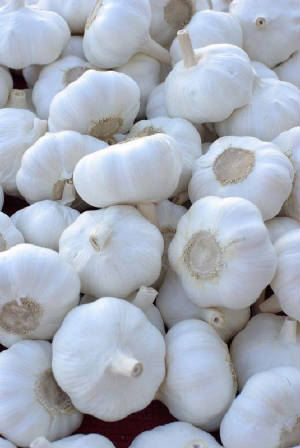
Royal (Jinxiang) Garlic Co., Ltd.
 |
|||||
|
Royal (Jinxiang) Garlic Co., Ltd. |
|||||
|
Home | about us | White Garlic | Garlic Product | Other | Europe PGI | Jinxiang | Health Benefit | Contact us
|
|||||
|
|
||||||||||||||||
     
|
Garlic may be applied to breads to create a variety of classic dishes such as garlic bread, garlic toast, bruschetta,
crostini and canapé. Oils are often flavored with garlic cloves. These infused oils are used to season all categories of vegetables,
meats, breads and pasta. In some cuisine, the young bulbs are pickled for 3–6 weeks in a mixture of sugar, salt, and
spices. In eastern Europe, the shoots are pickled and eaten as an appetizer. Immature scapes are tender and edible. They are
also known as "garlic spears", "stems", or "tops". Scapes generally have a milder taste than cloves. They are often used in
stir frying or prepared like asparagus. Garlic leaves are a popular vegetable in many parts of Asia. The leaves are cut, cleaned,
and then stir-fried with eggs, meat, or vegetables. Mixing garlic with eggs and olive oil produces aioli. Garlic, oil, and
a chunky base produce skordalia. Blending garlic, almond, oil, and soaked bread produces ajoblanco. Garlic powder has a different
taste than fresh garlic. If used as a substitute for fresh garlic, 1/8 teaspoon of garlic powder is equivalent to one clove
of garlic.
Garlic has been found to have antibacterial, antiviral, and antifungal activity. Garlic is also claimed to help
prevent heart disease (including atherosclerosis, high cholesterol, and high blood pressure) and cancer. Animal studies, and
some early investigational studies in humans, have suggested possible cardiovascular benefits of garlic. A Czech study found
that garlic supplementation reduced accumulation of cholesterol on the vascular walls of animals. Another study had similar
results, with garlic supplementation significantly reducing aortic plaque deposits of cholesterol-fed rabbits. Another study
showed that supplementation with garlic extract inhibited vascular calcification in human patients with high blood cholesterol.
The known vasodilative effect of garlic is possibly caused by catabolism of garlic-derived polysulfides to hydrogen sulfide
in red blood cells, a reaction that is dependent on reduced thiols in or on the RBC membrane. Hydrogen sulfide is an endogenous
cardioprotective vascular cell-signaling molecule. In 2007, the BBC reported that Allium sativum may have other beneficial
properties, such as preventing and fighting the common cold. This assertion has the backing of long tradition in herbal medicine,
which has used garlic for hoarseness and coughs. The Cherokee also used it as an expectorant for coughs and croup. Allium
sativum has been found to reduce platelet aggregation and hyperlipidemia. Garlic is also alleged to help regulate blood sugar
levels. Regular and prolonged use of therapeutic amounts of aged garlic extracts lower blood homocysteine levels and has shown
to prevent some complications of diabetes mellitus. In 1858, Louis Pasteur observed garlic's antibacterial activity, and it
was used as an antiseptic to prevent gangrene during World War I and World War II. More recently, it has been found from a
clinical trial that a mouthwash containing 2.5% fresh garlic shows good antimicrobial activity. In modern naturopathy, garlic
is used as a treatment for intestinal worms and other intestinal parasites, both orally and as an anal suppository. Garlic
cloves are used as a remedy for infections (especially chest problems), digestive disorders, and fungal infections such as
thrush. |
      |
||||||||||||||
|
|
||||||||||||||||